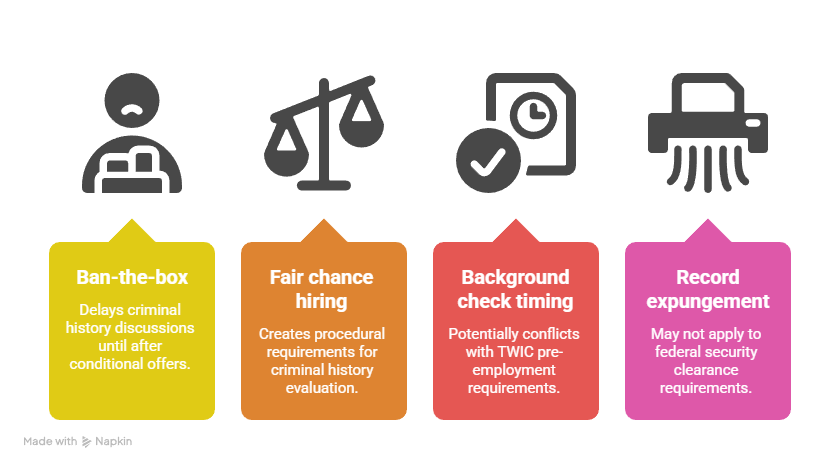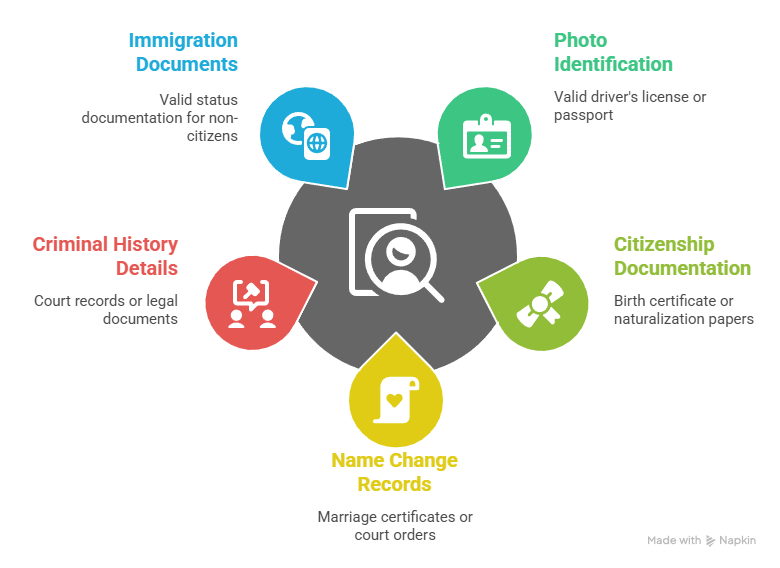TWIC card background check requirements follow uniform federal standards across all states, administered by the Transportation Security Administration to ensure consistent maritime security screening nationwide. While processing times and enrollment center accessibility vary by location, the core eligibility criteria and criminal history disqualifiers remain identical for all applicants regardless of their state of residence.
Key Takeaways
- TWIC background check standards are federally mandated and apply uniformly across all 50 states without variation in eligibility criteria or disqualification factors.
- Processing times range from 28-48 days depending on state location, with coastal states typically offering more enrollment centers and faster processing.
- Criminal history disqualifiers include permanent bars for terrorism-related offenses and seven-year waiting periods for serious felonies like assault with intent to murder.
- State-specific factors affecting processing include maritime industry size, seasonal employment patterns, and enrollment center distribution density.
- Appeal processes for denied applications follow standardized federal procedures regardless of the applicant's state or where background issues occurred.
- Maritime workers can strategically time applications to avoid peak periods in their specific state's shipping or fishing seasons.
Understanding TWIC Card Background Check Requirements

The Transportation Worker Identification Credential represents a critical security measure for maritime industry professionals accessing restricted port facilities and vessels. Federal regulations mandate comprehensive background screening through the Transportation Security Administration, ensuring consistent security standards across all U.S. ports and waterways. This standardized approach means that TWIC requirements remain uniform nationwide, though implementation logistics vary significantly between states.
TWIC background checks examine criminal history, immigration status, and terrorism-related databases to identify potential security risks. The screening process evaluates both permanent and interim disqualifying factors, with some offenses creating absolute bars to eligibility while others establish waiting periods. Understanding these requirements helps maritime workers and employers navigate the complex intersection of federal security regulations and state-specific processing considerations.
Federal vs. State Authority in TWIC Processing
Federal Oversight Structure
The Transportation Security Administration maintains exclusive authority over TWIC eligibility standards, ensuring uniform application of security criteria across all states. Federal jurisdiction covers background check procedures, disqualification standards, and appeals processes without delegation to state authorities. This centralized approach prevents regional variations that could compromise maritime security or create unfair advantages for workers in different states.
TSA coordinates with FBI criminal history databases, Department of Homeland Security immigration records, and international terrorism screening databases. The comprehensive federal screening approach ensures that criminal history from any jurisdiction receives appropriate evaluation under uniform standards.
State-Level Implementation Factors
While federal standards govern eligibility, states influence TWIC processing through enrollment center locations, application volumes, and regional processing capacity. Maritime industry concentration affects demand patterns, with major port states experiencing higher application volumes and potentially longer processing times. State economic factors, including seasonal employment patterns and industry-specific hiring cycles, create predictable fluctuations in TWIC application demand.
Understanding state-specific implementation factors helps applicants choose optimal timing and locations for their TWIC applications, potentially reducing processing delays.
Application Processing Times by Region
Northeast Region Processing
The Northeast region demonstrates efficient processing through established maritime infrastructure and strategic enrollment center placement. Regional processing benefits from proximity to federal agencies and experienced maritime security personnel. However, seasonal variations in shipping and fishing industries create predictable demand surges that can extend processing times.
| State | Average Processing Time | Enrollment Centers | Peak Delay Periods |
| Connecticut | 30-38 days | 2 locations | Tourist season prep |
| Maine | 32-40 days | 2 locations | Lobster season preparation |
| Massachusetts | 30-38 days | 4 locations | Spring hiring cycles |
| New Hampshire | 32-38 days | 1 location | Summer maritime season |
| New York | 35-42 days | 8 locations | Summer maritime season |
| Rhode Island | 30-35 days | 1 location | Recreational boating season |
| Vermont | 35-40 days | 1 location | Limited maritime demand |
Northeast processing benefits from established maritime infrastructure and multiple enrollment centers. However, seasonal employment patterns in fishing and shipping industries can create application surges during specific periods.
Southeast Region Processing
The Southeast region handles substantial maritime commerce through major ports in Florida, Georgia, South Carolina, and North Carolina. Processing times remain consistent with national averages, though hurricane season preparations can temporarily increase application volumes. Gulf Coast states experience similar patterns related to offshore energy industry employment cycles.
| State | Average Processing Time | Enrollment Centers | Primary Maritime Industries |
| Alabama | 32-40 days | 2 locations | Port operations, shipbuilding |
| Delaware | 28-35 days | 1 location | Chemical transport, port services |
| Florida | 32-45 days | 12 locations | Cruise industry, international trade |
| Georgia | 30-38 days | 4 locations | Container shipping, logistics |
| Maryland | 28-35 days | 3 locations | Port of Baltimore, federal facilities |
| North Carolina | 32-38 days | 3 locations | Military support, fishing |
| South Carolina | 30-38 days | 2 locations | Container shipping, naval support |
| Virginia | 30-38 days | 4 locations | Military support, coal export |
| West Virginia | 38-42 days | 1 location | River transport, coal |
Regional characteristics include higher application volumes from major ports, seasonal variations from tourism and fishing industries, weather-related delays during hurricane seasons, and consistent energy sector demand from offshore oil and gas industries.
Midwest Region Processing
Midwest maritime operations center on Great Lakes shipping and river transportation systems, creating unique seasonal demand patterns. Processing times reflect lower overall maritime employment compared to coastal regions, though seasonal navigation opening creates predictable application surges. Regional enrollment centers serve large geographic areas, potentially requiring longer travel for applicants.
| State | Average Processing Time | Enrollment Centers | Seasonal Factors |
| Illinois | 35-42 days | 3 locations | Spring navigation opening |
| Indiana | 38-42 days | 2 locations | Steel shipping season |
| Michigan | 35-42 days | 4 locations | Great Lakes transport, auto shipping |
| Minnesota | 38-45 days | 2 locations | Iron ore shipping season |
| Ohio | 38-45 days | 3 locations | Great Lakes shipping, steel transport |
| Pennsylvania | 35-40 days | 4 locations | River transport, steel shipping |
| Wisconsin | 35-42 days | 2 locations | Great Lakes shipping season |
Great Lakes shipping seasons significantly impact application timing, with most maritime activity concentrated in ice-free months from April through November.
West Coast Processing
West Coast states handle extensive international trade and fishing operations, generating substantial TWIC application volumes throughout the year. Processing infrastructure accommodates high demand efficiently, though seasonal fishing patterns and trade fluctuations create variable processing loads. Alaska's unique geographic challenges and seasonal employment patterns can extend processing times beyond continental averages.
| State | Average Processing Time | Enrollment Centers | Industry Drivers |
| Alaska | 35-45 days | 3 locations | Commercial fishing, oil transport |
| California | 30-42 days | 15 locations | International shipping, fishing |
| Hawaii | 35-48 days | 2 locations | Tourism vessels, inter-island transport |
| Oregon | 32-40 days | 3 locations | Lumber export, fishing |
| Washington | 32-42 days | 6 locations | International trade, fishing |
Pacific region processing benefits from modern enrollment infrastructure and streamlined procedures, though international trade fluctuations and seasonal fishing patterns create variable application demands throughout the year.
Southwest and Mountain Region Processing
Southwest maritime operations focus primarily on river systems, offshore energy, and international trade through Gulf ports. Mountain states have limited maritime requirements, typically serving river transport and reservoir-based operations. Processing times reflect lower demand volumes but may require longer travel distances to reach enrollment centers.
| State | Average Processing Time | Enrollment Centers | Regional Characteristics |
| Arizona | 38-45 days | 2 locations | Limited river transport |
| Colorado | 40-45 days | 2 locations | Minimal maritime requirements |
| Louisiana | 32-42 days | 6 locations | Oil refining, river commerce |
| Nevada | 38-42 days | 1 location | Limited maritime demand |
| New Mexico | 40-48 days | 1 location | Minimal maritime activity |
| Texas | 32-45 days | 10 locations | Oil refining, international trade |
| Utah | 42-48 days | 1 location | Limited maritime requirements |
Regional processing reflects the concentration of maritime activity in Louisiana and Texas Gulf Coast areas, while mountain states serve primarily as pass-through locations for workers seeking maritime employment elsewhere.
Criminal History Disqualifiers by Offense Category
Permanent Disqualifying Offenses
Federal regulations establish permanent bars for specific offense categories that pose unacceptable security risks to maritime transportation systems. These disqualifiers apply regardless of when the conviction occurred, rehabilitation efforts, or mitigating circumstances. Permanent disqualification reflects the critical security importance of maritime infrastructure and the potential consequences of security breaches.
Terrorism and National Security Offenses:
- Espionage or conspiracy to commit espionage
- Sedition or conspiracy to commit sedition
- Treason or conspiracy to commit treason
- Terrorism-related offenses under federal law
- Aircraft piracy or conspiracy to commit aircraft piracy
Transportation Security Violations:
- Improper transportation of hazardous materials
- Unlawful possession, use, sale, or distribution of explosives or explosive devices
- Murder or conspiracy to commit murder
- Aircraft piracy under federal jurisdiction
Permanent disqualifiers reflect the most serious threats to transportation security and cannot be waived through appeals or rehabilitation demonstrations. These standards apply uniformly across all states without exception.
Interim Disqualifying Offenses
Interim disqualifiers create seven-year waiting periods from conviction date, release from incarceration, or completion of parole/probation, whichever is later. These offenses demonstrate serious criminal behavior but allow for rehabilitation over time. Understanding interim disqualifier timelines helps applicants determine eligibility timing and plan career transitions accordingly.
Violent Crime Categories:
- Assault with intent to murder: Creates seven-year bar from conviction or release
- Kidnapping or conspiracy to commit kidnapping: Seven-year waiting period applies
- Rape or aggravated sexual abuse: Interim disqualification with appeals possible
- Robbery or conspiracy to commit robbery: Seven-year bar with rehabilitation consideration
Drug-Related Offenses:
- Unlawful possession, use, sale, manufacture, or distribution of controlled substances: Seven-year interim disqualification applies to serious drug crimes, though simple possession may receive different treatment depending on circumstances and state of conviction.
- Conspiracy to commit drug trafficking: Creates interim bar with potential for successful appeals based on rehabilitation evidence and role in offense.
Interim disqualifiers allow for individual assessment of rehabilitation efforts and changed circumstances through the appeals process. However, the seven-year waiting period applies uniformly across all states regardless of local variations in sentencing or rehabilitation programs.
State-Specific Processing Variations
Processing efficiency varies significantly between states based on maritime industry concentration, enrollment center distribution, and regional demand patterns. Understanding these variations helps applicants choose optimal timing and potentially alternative locations for their TWIC applications. Some states offer faster processing due to lower demand, while others provide more convenient access despite longer processing times.
High-Volume Processing States:
- California: Multiple major ports generate consistent high demand
- Florida: Cruise industry and international trade create year-round applications
- Texas: Gulf Coast energy and shipping operations drive steady volume
- New York: International commerce and passenger vessels maintain demand
- Washington: Pacific trade and Alaska fishing support create seasonal surges
Efficient Processing Regions:
- Delaware: Single major port with streamlined processing
- Maryland: Federal facility proximity enables efficient coordination
- South Carolina: Modern port facilities with optimized enrollment procedures
Processing variations reflect each state's unique combination of maritime infrastructure, industry demands, and enrollment center capacity rather than differences in federal standards or procedures.
Seasonal Application Patterns
Maritime industries demonstrate predictable seasonal patterns that significantly impact TWIC application processing times. Understanding these cycles helps applicants and employers plan strategically for credential acquisition. Seasonal variations occur consistently across similar industries regardless of state location, though timing may shift based on regional climate and economic factors.
Spring Preparation Cycles:
- Great Lakes shipping preparation: March-April application surges
- Commercial fishing seasons: Pre-season credential renewal
- Tourism industry hiring: Preparation for summer operations
- Construction season begins: Maritime infrastructure projects
Summer Peak Periods:
- Cruise industry employment: Seasonal worker influx
- Recreational maritime services: Charter and tour operations
- International shipping: Peak cargo movement seasons
- Offshore energy operations: Weather-dependent project timing
Understanding seasonal patterns allows strategic application timing to avoid peak processing periods and ensure credential availability when employment opportunities arise.
Background Check Process Timeline
Initial Application Processing
TWIC background checks begin immediately upon biometric data collection at enrollment centers, with federal databases receiving queries within 24-48 hours of application submission. Initial processing involves automated screening against multiple federal databases, including FBI criminal history records, immigration databases, and terrorism watch lists. This automated phase typically completes within 5-7 business days, identifying most straightforward approvals or obvious disqualifications.
Complex cases requiring manual review enter extended processing queues where trained analysts evaluate criminal history details, immigration status complications, or database inconsistencies. Manual review cases represent approximately 15-20% of total applications and account for most processing delays beyond standard timeframes. Understanding this two-tier system helps applicants set appropriate expectations for their specific circumstances.
Appeals and Reconsideration Process
Denied TWIC applications trigger automatic notification letters explaining specific disqualification reasons and appeal rights. Applicants have 60 days from notification to file appeals through standardized federal procedures that apply uniformly across all states. The appeals process allows presentation of rehabilitation evidence, clarification of criminal history details, or correction of factual errors in background check results.
Appeals typically require 90-120 days for complete processing, though complex cases involving extensive criminal history or documentation requirements may extend longer. Success rates vary significantly based on disqualification type, with factual corrections showing higher success rates than attempts to overcome substantive criminal history disqualifiers. Professional legal assistance often proves valuable for complex appeals involving multiple jurisdictions or serious criminal history.
Employment Law Considerations
State Employment Law Interactions
While TWIC requirements follow federal standards, state employment laws create additional considerations for maritime employers and workers. Some states impose restrictions on criminal history inquiries that may conflict with federal TWIC disclosure requirements, creating complex compliance scenarios. California's Fair Chance Act, for example, limits pre-employment criminal history inquiries while federal regulations require TWIC possession for maritime access.
Key State Law Interactions:

- Ban-the-box legislation: May delay criminal history discussions until after conditional offers
- Fair chance hiring laws: Create procedural requirements for criminal history evaluation
- Background check timing restrictions: Potentially conflict with TWIC pre-employment requirements
- Record expungement effects: May not apply to federal security clearance requirements
Maritime employers must navigate both federal TWIC mandates and state employment protections, often requiring specialized legal guidance to ensure compliance with potentially conflicting requirements.
Employer Compliance Strategies
Maritime employers face unique challenges balancing federal security requirements with state employment protections and practical hiring needs. Effective compliance strategies address both legal requirements and operational efficiency while protecting employer interests and worker rights. Understanding state-specific variations in employment law helps employers develop tailored approaches for different operational locations.
Recommended Compliance Approaches:
- Early TWIC requirement disclosure: Clearly communicate federal mandates during recruitment
- Conditional offer procedures: Structure hiring processes to comply with state timing restrictions
- Alternative assignment options: Develop non-maritime roles for workers during credential processing
- Legal consultation protocols: Establish relationships with employment law specialists familiar with maritime security requirements
Proactive compliance planning reduces hiring delays and legal risks while ensuring operational security requirements are met effectively.
Cost Considerations Across States
TWIC card fees remain consistent nationwide at $125.25 for new applications and renewals, with replacement cards costing $60.00. However, total costs vary significantly between states due to travel requirements, lost wages during enrollment appointments, and processing-related expenses. Understanding these additional costs helps workers and employers budget effectively for TWIC compliance.
| State Category | Direct Costs | Indirect Costs | Total Estimated Cost |
| High-Density Enrollment | $125.25 fee | Minimal travel, 2-hour appointment | $125-175 |
| Medium-Density Enrollment | $125.25 fee | Regional travel, day off work | $200-350 |
| Low-Density Enrollment | $125.25 fee | Overnight travel, multiple days | $400-600 |
Geographic accessibility significantly impacts total TWIC acquisition costs, with rural areas and states with limited enrollment centers requiring substantial additional investment in travel and time off work.
Financial Planning for TWIC Requirements
Maritime workers should budget for both direct TWIC costs and associated expenses when planning credential acquisition. Employers may choose to reimburse TWIC costs as part of recruitment and retention strategies, particularly in competitive maritime labor markets. Understanding the full cost structure helps both parties make informed decisions about timing and financial responsibility.
Budget Planning Considerations:
- Application fees: Standard federal rates apply nationwide
- Travel expenses: Vary dramatically by enrollment center accessibility
- Lost wages: Time off work for enrollment appointments
- Renewal timing: Five-year validity requires advance planning
- Replacement costs: Lower fees for lost or damaged cards
Strategic financial planning ensures TWIC requirements don't create undue hardship for maritime workers while enabling employers to factor compliance costs into hiring budgets.
Best Practices for Applicants
Application Timing Strategy
Successful TWIC applicants understand the importance of strategic timing to minimize processing delays and ensure credential availability when needed. Early application submission allows buffer time for potential complications while avoiding peak processing periods reduces overall timeline. Understanding state-specific seasonal patterns enables optimal timing decisions based on local maritime industry cycles.
Optimal Timing Guidelines:
- Apply 60-90 days before employment start date
- Avoid industry-specific peak application periods
- Consider renewal timing to prevent employment gaps
- Plan for potential appeals or complications
- Coordinate with employer hiring timelines
Strategic timing requires understanding both personal circumstances and broader industry patterns to achieve optimal results.
Documentation Preparation
Thorough documentation preparation significantly improves TWIC application success rates and processing speed. Complete and accurate documentation reduces processing delays while proper organization demonstrates professionalism and attention to detail. Understanding required documentation helps applicants gather necessary materials efficiently.
Essential Documentation Checklist:

- Government-issued photo identification: Valid driver's license, passport, or state ID
- Citizenship documentation: Birth certificate, naturalization papers, or passport
- Name change records: Marriage certificates, divorce decrees, or court orders if applicable
- Criminal history details: Court records, disposition papers, or legal documentation
- Immigration documents: Valid status documentation for non-citizens
Proper documentation preparation prevents appointment delays and ensures smooth processing through all stages of the background check process.
State-by-State TWIC Processing Comparison
The Transportation Security Administration processes TWIC applications through regional centers that serve multiple states, creating distinct processing patterns across different geographic areas. While federal standards remain uniform, each state's maritime industry size, enrollment center distribution, and seasonal employment patterns influence application volumes and processing efficiency. Understanding these state-specific factors helps applicants plan their TWIC acquisition timeline more effectively.
East Coast Processing
East Coast states benefit from established maritime infrastructure and high port activity, creating efficient processing systems despite substantial application volumes. The region's concentration of major international ports, military facilities, and commercial fishing operations generates consistent year-round demand for TWIC credentials. Processing times reflect the balance between high-capacity enrollment centers and elevated application volumes from diverse maritime industries.
| State | Processing Time | Enrollment Centers | Primary Industries | Peak Application Periods |
| Connecticut | 30-38 days | 2 | Maritime services, ferry operations | Tourist season prep |
| Delaware | 28-35 days | 1 | Chemical transport, port services | Year-round steady demand |
| Florida | 32-45 days | 12 | Cruise industry, international trade | Hurricane season prep |
| Georgia | 30-38 days | 4 | Container shipping, logistics | Fall shipping season |
| Maine | 32-40 days | 2 | Lobster industry, paper transport | Lobster season preparation |
| Maryland | 28-35 days | 3 | Port of Baltimore, federal facilities | Year-round government demand |
| Massachusetts | 30-38 days | 4 | Fishing, ferry services | Summer employment surge |
| New Hampshire | 32-38 days | 1 | Limited maritime operations | Summer season |
| New Jersey | 30-40 days | 5 | Container ports, chemical transport | Peak shipping months |
| New York | 35-42 days | 8 | International commerce, passenger vessels | Spring hiring cycles |
| North Carolina | 32-38 days | 3 | Military support, fishing | Military contract cycles |
| Rhode Island | 30-35 days | 1 | Maritime services, fishing | Recreational season |
| South Carolina | 30-38 days | 2 | Container shipping, naval support | Port expansion periods |
| Vermont | 35-40 days | 1 | Limited maritime demand | Minimal variation |
| Virginia | 30-38 days | 4 | Military support, coal export | Defense contract cycles |
East Coast processing demonstrates the efficiency possible when robust maritime infrastructure meets established federal processing systems. The region's diverse maritime economy, from Maine's lobster industry to Florida's cruise operations, creates varied but predictable seasonal demand patterns that experienced enrollment centers manage effectively.
Gulf Coast Processing
Gulf Coast states serve as critical hubs for energy sector maritime operations and international trade through major ports in Texas and Louisiana. The region's unique combination of offshore oil operations, petrochemical transport, and Mississippi River commerce creates distinct processing patterns influenced by energy industry cycles. Processing times reflect both the substantial maritime workforce requirements and the specialized nature of Gulf Coast maritime operations.
| State | Processing Time | Enrollment Centers | Primary Industries | Peak Application Periods |
| Alabama | 32-40 days | 2 | Port operations, shipbuilding | Spring construction season |
| Louisiana | 32-42 days | 6 | Oil refining, river commerce | Energy sector cycles |
| Texas | 32-45 days | 10 | Oil refining, international trade | Energy industry hiring |
Gulf Coast processing reflects the region's critical role in U.S. energy infrastructure and international trade, with enrollment centers strategically positioned to serve major port complexes and offshore operations. The concentration of hazardous materials transport and energy sector employment creates consistent demand for TWIC credentials throughout the year.
West Coast Processing
West Coast states handle extensive international trade volumes and diverse fishing operations, requiring robust processing capacity to serve the nation's primary Pacific trade gateway. The region's combination of major container ports, commercial fishing fleets, and tourism-related maritime activities generates substantial TWIC application volumes. Processing infrastructure has evolved to accommodate both high-volume demand and the unique requirements of Alaska's remote maritime operations.
| State | Processing Time | Enrollment Centers | Primary Industries | Peak Application Periods |
| Alaska | 35-45 days | 3 | Commercial fishing, oil transport | Pre-fishing season (March-May) |
| California | 30-42 days | 15 | International shipping, fishing | Summer maritime hiring |
| Hawaii | 35-48 days | 2 | Tourism vessels, inter-island transport | Winter tourist season |
| Oregon | 32-40 days | 3 | Lumber export, fishing | Timber shipping season |
| Washington | 32-42 days | 6 | International trade, fishing | Alaska fishing preparation |
West Coast processing demonstrates sophisticated coordination between high-volume international trade requirements and seasonal fishing industry demands. The region's enrollment centers manage complex seasonal patterns while maintaining efficient processing for year-round commercial shipping operations.
Great Lakes Region Processing
Great Lakes states serve unique seasonal maritime operations focused on bulk cargo transport and regional shipping during ice-free months. The region's distinctive operating season creates concentrated application periods as maritime operations prepare for annual navigation seasons. Processing times reflect both the seasonal nature of Great Lakes shipping and the region's substantial manufacturing-related maritime transport requirements.
| State | Processing Time | Enrollment Centers | Primary Industries | Peak Application Periods |
| Illinois | 35-42 days | 3 | Great Lakes shipping, river transport | Spring navigation opening |
| Indiana | 38-42 days | 2 | Steel shipping, river transport | Manufacturing cycles |
| Michigan | 35-42 days | 4 | Great Lakes transport, auto shipping | Shipping season opening |
| Minnesota | 38-45 days | 2 | Iron ore shipping, Great Lakes | Spring navigation season |
| Ohio | 38-45 days | 3 | Great Lakes shipping, steel transport | Industrial production peaks |
| Pennsylvania | 35-40 days | 4 | River transport, steel shipping | Manufacturing cycles |
| Wisconsin | 35-42 days | 2 | Great Lakes shipping | Navigation season |
Great Lakes processing accommodates the region's unique seasonal maritime economy, where most commercial shipping activity concentrates in the April through December navigation season. Enrollment centers coordinate efficiently with industry cycles to ensure workforce readiness for annual shipping season demands.
Interior and Mountain States Processing
Interior states maintain limited maritime operations primarily focused on river transport systems and specialized logistics support. These states typically serve as transit points for maritime workers seeking employment in coastal regions, resulting in lower but steady application volumes. Processing times may extend slightly due to limited enrollment center availability, though demand patterns remain relatively stable throughout the year.
| State | Processing Time | Enrollment Centers | Primary Industries | Peak Application Periods |
| Arizona | 38-45 days | 2 | Limited river transport | Minimal seasonal variation |
| Colorado | 40-45 days | 2 | Minimal maritime requirements | Limited demand |
| Nevada | 38-42 days | 1 | Limited maritime demand | Minimal variation |
| New Mexico | 40-48 days | 1 | Minimal maritime activity | Limited demand |
| Utah | 42-48 days | 1 | Limited maritime requirements | Minimal demand |
| West Virginia | 38-42 days | 1 | River transport, coal shipping | Energy sector cycles |
Interior state processing serves primarily transitional workforce needs and specialized river transport operations, with enrollment centers strategically located to provide reasonable access despite lower regional maritime employment. Processing times reflect the balance between limited local demand and the geographic challenges of serving large rural areas.
Conclusion
TWIC card background check requirements maintain consistent federal standards across all states, ensuring uniform security screening for maritime transportation workers nationwide. While processing times and enrollment center accessibility vary by location, the core eligibility criteria and disqualification standards remain identical regardless of applicant residence or employment location. Understanding these state-specific variations in processing and accessibility helps applicants and employers plan effectively for TWIC compliance requirements. Maritime industry professionals should work with experienced employment law attorneys to navigate the intersection of federal TWIC requirements and state-specific employment regulations.
Frequently Asked Questions
What disqualifies you from getting a TWIC card?
Permanent disqualifiers include terrorism-related crimes, espionage, sedition, and treason, while interim disqualifiers like assault with intent to murder, kidnapping, and drug trafficking create seven-year waiting periods. The same disqualification criteria apply nationwide regardless of where convictions occurred.
How long does a TWIC background check take?
TWIC background checks typically take 30-45 days to complete, though processing times may vary by region based on application volume and enrollment center capacity. High-volume maritime states may experience slightly longer processing times during peak application periods.
Do TWIC card requirements vary by state?
No, TWIC card requirements follow uniform federal standards administered by the TSA across all states. While enrollment center locations and processing times may vary, eligibility criteria and background check standards remain consistent nationwide.
Can I appeal a TWIC card denial?
Yes, applicants can appeal TWIC card denials within 60 days of notification through a standardized federal appeals process. The appeal examines whether disqualifying information was correctly applied and considers relevant mitigating circumstances or rehabilitation evidence.
Which jobs require a TWIC card?
Maritime workers accessing secure port facilities, commercial fishing vessel crews, longshoremen, shipyard employees, truckers entering maritime areas, and certain rail workers require TWIC cards. Requirements apply uniformly across all states for these federally regulated positions.
How much does a TWIC card cost?
TWIC cards cost $125.25 for new applications and renewals, with replacement cards costing $60.00. These federal fees apply consistently across all states, though travel costs to enrollment centers may vary based on location and accessibility.
Additional Resources
- Transportation Security Administration TWIC Program Overview
https://www.tsa.gov/for-industry/twic - Federal Maritime Commission Security Regulations
https://www.fmc.gov/about-the-fmc/bureaus-offices-administration/security/ - Coast Guard TWIC Reader Requirements
https://www.dco.uscg.mil/Our-Organization/Assistant-Commandant-for-Prevention-Policy/National-Maritime-Center/ - Maritime Transportation Security Act Full Text
https://www.congress.gov/bill/107th-congress/house-bill/3983 - TSA Background Check Disqualifiers List
https://www.tsa.gov/disqualifying-offenses-factors - TWIC Enrollment Center Locator
https://universalenroll.dhs.gov/locator
Still have questions?
Get in touch with our team today for a personalized demo and discover how our tailored volume pricing and packages can drive results for your business!
How useful was this page?*
Note: your comments are anonymous. We use them to improve the website. Do not include any personal details.
Visit our FCRA Compliance Tool or leave a message here if you need a response.
From the blog Explore the GCheck Content Hub

How to Perform OIG Exclusion Screening: Step-by-Step Guide
20 Nov, 2025 • 24 min read
Illinois Tenant Screening Laws: Chicago & Cook County Compliance Guide for Landlords
19 Nov, 2025 • 20 min read
FCRA Penalties for Small Businesses: 2025 Compliance Costs & Violation Fines
12 Nov, 2025 • 20 min readThe information provided in this article is for general informational and educational purposes only and should not be construed as legal advice or a substitute for consultation with qualified legal counsel. While we strive to ensure accuracy, employment screening laws and regulations—including but not limited to the Fair Credit Reporting Act (FCRA), Equal Employment Opportunity Commission (EEOC) guidelines, state and local ban-the-box laws, industry-specific requirements, and other applicable federal, state, and local statutes—are subject to frequent changes, varying interpretations, and jurisdiction-specific applications that may affect their implementation in your organization. Employers and screening decision-makers are solely responsible for ensuring their background check policies, procedures, and practices comply with all applicable laws and regulations relevant to their specific industry, location, and circumstances. We strongly recommend consulting with qualified employment law attorneys and compliance professionals before making hiring, tenant screening, or other decisions based on background check information.

